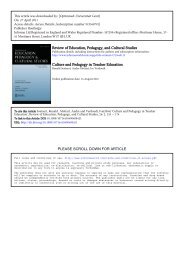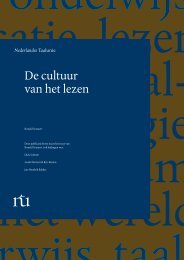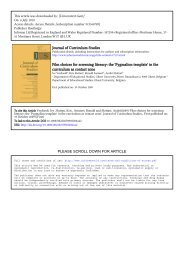a view informed by the problems of traditional literacy in a digital age
a view informed by the problems of traditional literacy in a digital age
a view informed by the problems of traditional literacy in a digital age
You also want an ePaper? Increase the reach of your titles
YUMPU automatically turns print PDFs into web optimized ePapers that Google loves.
Downloaded <strong>by</strong> [University <strong>of</strong> Gent] at 06:46 09 December 2011<br />
Ronald Soetaert & Bart Bonamie<br />
up with conv<strong>in</strong>c<strong>in</strong>g rationales, rationales that also can conv<strong>in</strong>ce <strong>the</strong> general<br />
public. We would like to stress <strong>the</strong> fact that <strong>the</strong> study <strong>of</strong> langu<strong>age</strong>s and<br />
culture <strong>in</strong> particular can teach us a k<strong>in</strong>d <strong>of</strong> critical <strong>literacy</strong> towards new<br />
media.<br />
Apart from <strong>the</strong> fact that <strong>the</strong> new media will have deep implications for<br />
artistic expression, we can also experience how <strong>in</strong> art and langu<strong>age</strong> <strong>the</strong><br />
expressions <strong>of</strong> <strong>the</strong> future are explored and constructed. The cultural<br />
herit<strong>age</strong> will be <strong>in</strong>fluenced <strong>by</strong> <strong>the</strong>se new <strong>in</strong>terfaces: ‘Hypertext is <strong>in</strong>vad<strong>in</strong>g<br />
<strong>the</strong> <strong>traditional</strong> realms <strong>of</strong> content provision <strong>in</strong> data, text, sound, and video. It<br />
is chang<strong>in</strong>g <strong>the</strong> rules <strong>of</strong> space-based stor<strong>age</strong>, distribution, and delivery <strong>of</strong><br />
books, records, tapes, video and film’ (De Kerckhove, 1997, p. xxviii).<br />
Digitalisation has dematerialised <strong>traditional</strong> memory-support devices such as<br />
books, tapes and records … Indeed, we are witness<strong>in</strong>g a major shift <strong>in</strong><br />
culture, from memory-based to <strong>in</strong>telligence-based production: ‘We are<br />
mov<strong>in</strong>g from <strong>the</strong> era <strong>of</strong> ‘replay’ to that <strong>of</strong> ‘remake’. We are develop<strong>in</strong>g<br />
computer-assisted cognitive habits and computer-assisted forms <strong>of</strong><br />
collaboration – new forms, <strong>in</strong> fact, <strong>of</strong> connectedness’ (De Kerckhove, 1997,<br />
p. xxix).<br />
How will technology transform content? Or enhance a transformation<br />
that has already started? As <strong>the</strong> new media are re<strong>in</strong>vent<strong>in</strong>g culture, <strong>the</strong>y also<br />
re<strong>in</strong>vent <strong>the</strong> ‘discipl<strong>in</strong>es’ we are teach<strong>in</strong>g, <strong>the</strong> <strong>in</strong>stitutions <strong>in</strong> which we are<br />
teach<strong>in</strong>g, <strong>the</strong> way <strong>in</strong> which we are learn<strong>in</strong>g. Indeed, new media are more<br />
about access and connectedness; new media are also content-driven.<br />
In produc<strong>in</strong>g <strong>in</strong>formation, we all share <strong>the</strong> <strong>digital</strong> code (1s and 0s).<br />
Because all <strong>the</strong>se 1s and 0s can be changed, fixed ‘truth’ has been<br />
problematised. The results are cont<strong>in</strong>gent, transformable and situated truths.<br />
So, <strong>the</strong> arts and humanities become a prov<strong>in</strong>ce <strong>of</strong> rhetoric: ‘Rhetoric<br />
becomes … a general <strong>the</strong>ory for all <strong>the</strong> arts, and, as well, <strong>the</strong> structure for a<br />
central curriculum <strong>in</strong> <strong>the</strong> arts and letters’ (Lanham, 1993, p. 16). For<br />
Lanham, langu<strong>age</strong>s are lead<strong>in</strong>g <strong>the</strong> dance; that ‘<strong>the</strong> arts, and <strong>the</strong> <strong>the</strong>oretical<br />
debate that tags along after <strong>the</strong>m, have done <strong>the</strong> lead<strong>in</strong>g, and digitisation<br />
has emerged as <strong>the</strong>ir condign embodiment’ (Lanham, 1993, p. 51). ‘Lead<strong>in</strong>g<br />
<strong>the</strong> dance’ is a nice compliment for langu<strong>age</strong> teachers, but leadership asks<br />
for a vision.<br />
Teach<strong>in</strong>g Langu<strong>age</strong>s and Literature <strong>in</strong> a Digital Age<br />
Book and Screen<br />
It is difficult to make prophecies but we cannot deny or escape <strong>the</strong> fact that<br />
new technologies affect <strong>the</strong> way we use langu<strong>age</strong>, and how new genres and<br />
discourses are emerg<strong>in</strong>g. From this perspective, it is tempt<strong>in</strong>g to start<br />
th<strong>in</strong>k<strong>in</strong>g about what is happen<strong>in</strong>g with read<strong>in</strong>g and writ<strong>in</strong>g because<br />
computers have a major impact on <strong>the</strong>se skills.<br />
132





